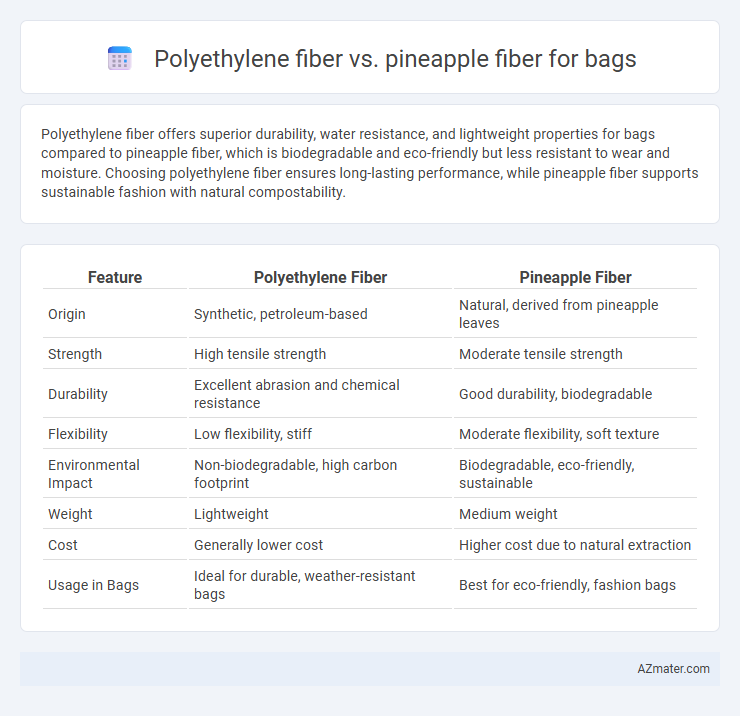Polyethylene fiber offers superior durability, water resistance, and lightweight properties for bags compared to pineapple fiber, which is biodegradable and eco-friendly but less resistant to wear and moisture. Choosing polyethylene fiber ensures long-lasting performance, while pineapple fiber supports sustainable fashion with natural compostability.
Table of Comparison
| Feature | Polyethylene Fiber | Pineapple Fiber |
|---|---|---|
| Origin | Synthetic, petroleum-based | Natural, derived from pineapple leaves |
| Strength | High tensile strength | Moderate tensile strength |
| Durability | Excellent abrasion and chemical resistance | Good durability, biodegradable |
| Flexibility | Low flexibility, stiff | Moderate flexibility, soft texture |
| Environmental Impact | Non-biodegradable, high carbon footprint | Biodegradable, eco-friendly, sustainable |
| Weight | Lightweight | Medium weight |
| Cost | Generally lower cost | Higher cost due to natural extraction |
| Usage in Bags | Ideal for durable, weather-resistant bags | Best for eco-friendly, fashion bags |
Introduction to Polyethylene and Pineapple Fibers
Polyethylene fiber is a synthetic polymer known for its high strength, lightweight properties, and resistance to moisture and chemicals, making it ideal for durable, water-resistant bags. Pineapple fiber, derived from the leaves of the pineapple plant, is a natural, biodegradable material prized for its eco-friendly qualities, breathability, and unique texture in sustainable bag production. These fibers differ significantly in environmental impact, durability, and texture, influencing their suitability for various bag designs and consumer preferences.
Material Properties of Polyethylene Fiber
Polyethylene fiber exhibits exceptional tensile strength, lightweight characteristics, and high resistance to moisture and chemicals, making it ideal for durable and water-resistant bags. Its low density contributes to comfortable carrying and prolonged bag lifespan, outperforming natural fibers like pineapple fiber in terms of durability and weather resistance. The synthetic nature of polyethylene fiber also ensures consistent quality and enhanced resistance to UV degradation compared to the organic properties of pineapple fiber.
Material Properties of Pineapple Fiber
Pineapple fiber is a natural, biodegradable material known for its high tensile strength, lightweight nature, and excellent breathability, making it ideal for eco-friendly bags. Unlike polyethylene fiber, which is synthetic and prone to microplastic pollution, pineapple fiber offers superior moisture absorption and durability while maintaining environmental sustainability. Its coarse texture and UV resistance contribute to long-lasting, sturdy bags that appeal to conscious consumers seeking sustainable alternatives.
Sustainability and Eco-Friendliness Comparison
Polyethylene fiber, a synthetic material derived from petrochemicals, poses environmental concerns due to its non-biodegradable nature and fossil fuel dependency, contributing to microplastic pollution when used in bags. Pineapple fiber, extracted from pineapple leaves through eco-friendly processes, offers a sustainable alternative with its biodegradability, low environmental impact, and promotion of agricultural waste utilization. Choosing pineapple fiber bags supports circular economy principles by reducing plastic waste and fostering renewable resource use, aligning with sustainable and eco-friendly product goals.
Strength and Durability Analysis
Polyethylene fiber exhibits superior tensile strength and resistance to abrasion compared to pineapple fiber, making it ideal for high-load bag applications. While pineapple fiber offers eco-friendly biodegradability, its lower durability and susceptibility to moisture weaken long-term performance. The enhanced durability of polyethylene fiber ensures longer lifespan and better load-carrying capacity in rugged conditions.
Aesthetic and Design Possibilities
Polyethylene fiber offers a smooth, uniform texture that supports vibrant color application and sleek, modern bag designs, appealing to minimalistic and high-fashion aesthetics. Pineapple fiber, derived from natural leaves, provides a unique, coarse texture with an organic look that enhances eco-friendly and artisanal bag styles, favoring intricate weaving and rustic patterns. Both fibers present distinct design possibilities, with polyethylene excelling in versatility and durability while pineapple fiber highlights sustainable elegance and tactile originality.
Cost and Production Efficiency
Polyethylene fiber offers lower raw material costs and faster production speeds due to its synthetic origin and well-established manufacturing processes, making it highly cost-efficient for mass production of bags. In contrast, pineapple fiber, derived from agricultural waste, tends to have higher production costs due to labor-intensive extraction and processing methods, limiting large-scale manufacturing efficiency. Pineapple fiber's eco-friendly appeal and biodegradability provide sustainability benefits, but its overall cost and production efficiency lag behind the more economical and scalable polyethylene fiber.
Weight and Comfort in Daily Use
Polyethylene fiber is lightweight and durable, making it ideal for bags that require both strength and ease of carrying during daily use. Pineapple fiber, derived from natural sources, offers breathable comfort but tends to be heavier and less flexible compared to synthetic fibers. The choice between polyethylene and pineapple fiber hinges on prioritizing weight efficiency versus natural comfort in everyday bag usage.
Popular Applications in Bag Manufacturing
Polyethylene fiber is widely used in bag manufacturing for its high durability, water resistance, and lightweight properties, making it ideal for reusable shopping bags and outdoor gear. Pineapple fiber, also known as Pina fiber, is favored in eco-friendly and luxury bags due to its natural texture, breathability, and biodegradability, appealing to sustainable fashion markets. Both fibers cater to distinct consumer demands, with polyethylene excelling in practical, everyday use and pineapple fiber targeting high-end, environmentally conscious products.
Conclusion: Choosing the Right Fiber for Your Bag
Polyethylene fiber offers exceptional durability, water resistance, and lightweight properties, making it ideal for everyday, heavy-duty bags that require longevity and minimal maintenance. Pineapple fiber, derived from sustainable sources, provides breathability, biodegradability, and a unique natural texture, appealing to eco-conscious consumers seeking biodegradable and stylish alternatives. Selecting the right fiber depends on prioritizing either high-performance synthetic durability with polyethylene or eco-friendly, natural aesthetics with pineapple fiber.

Infographic: Polyethylene fiber vs Pineapple fiber for Bag
 azmater.com
azmater.com